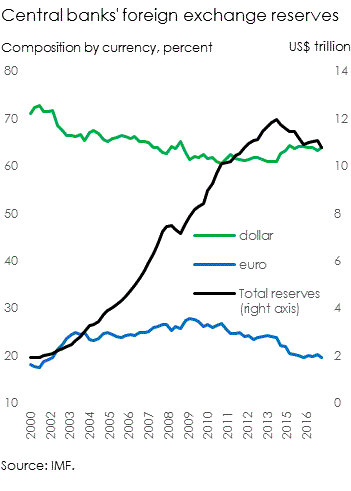Central bank reserves update
3 April 2017
Central bank foreign exchange reserves have continued to shrink but become more diversified. The latest IMF report on the composition of central bank foreign exchange reserves (COFER) through December 2016 shows that reserve holdings have maintained their downward trend. The composition by currency indicates broadly stable allocations but with a new high in the allocation to non-traditional reserve currencies. The allocation to renminbi is identified for the first time and shows a share of 1.1 percent in central banks’ foreign exchange reserves.
Foreign exchange reserves have declined by more than US$1 trillion from their peak in June 2014 to US$10.8 trillion (14.7 percent of world GDP). Over that same period, China's reserves declined by about US$1 trillion from US$4.0 in June 2014 to US$3.0 trillion in February 2017. This suggests that other central banks have kept their levels of reserves broadly stable.
The relative stability of foreign exchange holdings by central banks other than China is in principle positive. It reflects naturally fewer central bank interventions in foreign exchange markets and may offer some indications that central banks are on average less keen or less able to target specific exchange rate levels. Persistent high levels of exchange rate volatility underline that exchange markets remain unsettled.
The dollar has maintained a stable share at around 64 percent. While it remains below pre-global-financial-and-economic-crisis levels, it preserves its lead comfortably as the dominant reserve currency. The euro has continued to lose share dropping again to a low 19.7 percent well below its 2009 high of 27.7 percent to mostly smaller currencies. The yen rebounded somewhat. The pound has slid further since the Brexit vote to 4.4 percent and a local high of 4.9 percent in 2015. The share of currencies other than the dollar, euro, pound, yen and Swiss franc increased to a new high of 7.5 percent underscoring that diversification in central bank foreign exchange reserves has advanced.
The renminbi’s small share is indicative of the high threshold for penetrating central bank reserves. China will need to convince central banks that renminbi reserves can be used unconditionally and local banking sectors have to demand renminbi liquidity. Central banks will respond to probably rather than lead demand for renminbi assets. The renminbi’s share in central bank reserves will therefore offer a strong signal about the international demand for renminbi-denominated assets and the role of the renminbi to settle international transactions.
